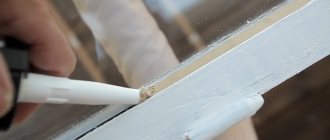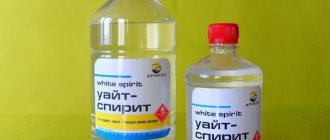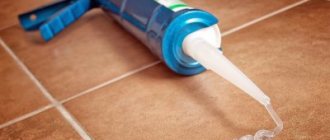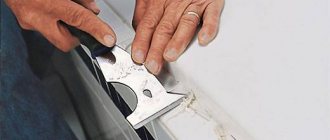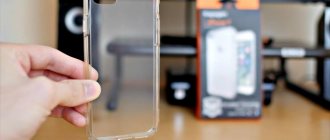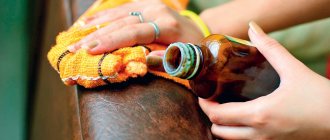Stretching and freezing - for fresh silicone that has not had time to harden
Silicone sealant is an extremely viscous and homogeneous substance. It penetrates into the tissue incredibly quickly. But still, if a pasty substance got on your shirt or pants literally 2-3 minutes ago, then you still have a chance to quickly get rid of it. Just:
- Stretch out the stained area on your clothing.
- The silicone stain will spread and turn into a thin film that can be easily removed even with a regular scraper or penknife. Remember: the thicker the film, the easier it will be to pick it up and clean the clothes.
- After the sealant, a greasy stain that is not very pleasing to the eye may remain. Just spray it with bleach or laundry detergent and it will go away.
An alternative way to get rid of the “freshly acquired” silicone nuisance on clothes is to put them in the freezer for two hours or, if it’s cold outside, send them to freeze on the balcony or in the yard. Frozen silicone can fall off even without your help.
If more than 10 minutes have passed since the “incident,” it is better not to use quick cleaning methods. Silicone is probably already, as they say, firmly attached to your jeans or T-shirt, and therefore express cleaning methods can only harm your clothes.
Other methods for removing sealant from the surface of fabric
- Vinegar essence. Clothes should be soaked in vinegar for half an hour. Then the remaining glue can be removed with a cloth, after which the material must be washed.
- Alcohol or regular vodka will help. You should hold the contaminated area of matter in alcohol for two minutes and rub it with a brush that is used in everyday life. Gloves on your hands and ventilation will protect you from the resulting volatile substances. For a cotton or linen T-shirt and other items made from these materials, such as pants, denim in the form of a jacket or jeans, you need to rub the items with cotton wool soaked in alcohol. The mattress, sofa and carpet rub with cotton wool because they cannot be washed in a laundry container.
- A convenient way to remove stains is to use acetone or white alcohol. First, place a rag soaked in the substance on the contaminated fabric. Then cover the rag with four layers of newspaper or notebook paper. Iron without overheating. Then you can wash your clothes as after normal soiling.
- Use a remover for the foam used during installation. You need to apply it to the affected area of the fabric and wait until a film forms, which can be scraped off with a sharp object. This is suitable for both colored items and white clothes, because not the slightest trace will remain.
- Apply acetone to the sweater or jacket, making sure that the colored fabric does not fade. You will have to hold it for sixty minutes. Then you need to wash these clothes in soapy water or wipe the area with it to remove any residue.
ARTICLE FOR YOU
How and with what to wash and remove soy sauce stains from clothes and linen
Methods for removing sealant from the surface of fabric
General recommendations for removing contaminants
You can use kerosene. But kerosene forces you to wait before starting the action. Dimexide and hot sunflower oil will help; solvents that act in cleaning car enamel are also used. Gasoline also removes the sealant from the fabric. Silicone sealants are more common in everyday life.
When exposed to acidic silicone, vinegar essence is used, containing seventy percent of the substance. Most adhesives that carry hermetic properties are one-component, and among the one-component adhesives there are acidic and neutral.
Acidic ones are cheaper, but they smell like vinegar. Neutral ones are more expensive, but they have no smell. On the packaging there is information about what kind of sealant it is: for cars, for construction or for some other purpose. If the sealant consists of two components, it hardens with the help of a catalyst.
This type of sealant is much less commonly found in stores. When glue is made with vinegar, it will dissolve in acetic acid. Having substances of a neutral nature in its composition, it is washed off with alcohol, oxides, amides, etc.
If mechanical means are used to clean the affected area of material, their surface should be rough. You can use a spatula, sandpaper, knife or blade.
Recommendations for removing stains
Conclusion
Sealant, a viscous and heat-resistant substance, fills gaps in the surface during repairs. It does not wash off normally if it gets on clothes. Products sold in stores or used at home help solve the problem. The sealant is easy to scrape off when the stain is very fresh, but the sealant hardens quickly.
You can remove dirt with objects that have a rough surface. There are products, industrial and folk, that specialize in cleaning the affected area of matter and clearing frozen stains.
To keep your hands safe, you should wear gloves, since the skin is exposed to danger and you may be left without the top layers of skin.
ARTICLE FOR YOU
How and with what to wash, remove unpleasant odors and urine stains from clothes and linen
Foam for installation is suitable for cleaning the affected area of the material. Gasoline, kerosene, dimexide, alcohol are suitable for quickly solving the problem. Vinegar essence is more suitable for sealant with an acidic composition.
Store-bought pollution-removing substances indicate how to use them to clean fabric from hermetic adhesive that has fallen on it. Adhesives have different compositions. The remaining greasy stains are dissolved with white spirit or washed with laundry soap.
Vinegar essence
Now let’s talk about ways to remove sealant that has become “associated” with clothing. First, about vinegar essence. First, remember 3 things.
Firstly, ordinary vinegar is absolutely not suitable for removing silicone “entrenched” in clothes. Use only “strong” (70−80%) essence.
Secondly, be prepared for the fact that after treatment with vinegar, the color of the fabric will slightly suffer.
Well, thirdly, be sure to work with the essence only with gloves, and if you have to use it a lot, then it is better to wear safety glasses and a respirator on your face - this substance is dangerous.
Here's how you do it:
- You take 70-80% vinegar essence, spread it on the silicone and wait 15 minutes.
- You take out a cloth and easily wipe off the finally softened “tamed” substance.
If you were unable to remove the silicone the first time, treat it with the essence again. You will succeed on the second try. Guarantee of success - 99.99 percent.
Be sure to send clothes freed from sticky misfortune to the wash, otherwise they will emit an extremely unpleasant vinegar aroma for a long time, and in high concentrations it is also very unsafe for health.
Rubbing alcohol or vodka
Silicone sealant does not tolerate vodka at all, not to mention medical alcohol. So, strong alcohol in your hands and:
- You drip a little vodka onto a cloth. You moisten the area covered with silicone with it. Then you wait for half an hour.
- You take a brush and start working with it diligently. You handle it for a couple of minutes, and the viscous substance, like mercury, will turn (or rather roll off) into small balls and finally leave the clothes alone.
Remember: when silicone glue comes into contact with alcohol, compounds that are very dangerous to health are formed. Therefore, when you process the paste composition, ventilate the room as best as possible, and also, if possible, put the same respirator on your face.
Features of different types of sealant
There are several types of sealant, which differ from each other by the polymer in the base composition. There are silicone, acrylic, polyurethane, butyl and bitumen. All of them differ in the level of viscosity, strength, and degree of adhesion to the material.
The most convenient to use and often found in everyday life are silicone sealants. They consist of one component, do not require additional catalysts and are immediately ready for use. Silicone sealants are either acidic or neutral based.
Under no circumstances should acid-based silicone be combined with alkali and alcohols; such stains are best removed with acidic solvents or vinegar.
Acrylic sealants are less moisture resistant than silicone, more fragile and susceptible to environmental factors. But polyurethane ones are much stronger, they are resistant to even the strongest factors, they are very difficult to damage and remove due to mechanical stress.
The most resistant is liquid bitumen. Only special solvent compounds can remove sealant from clothing.
Solvents - acetone, white spirit or gasoline
All of these silicone sealant solvents handle very well. Everything here is extremely easy and simple:
- You take a cloth, moisten it with one of the above-mentioned solvents, and apply it to the stick.
- Place 3-4 sheets of newspaper or several pages from a regular notebook on top of the rag.
- You turn on the iron, heat it up and iron the paper with it.
- You wait a little (if you get bored, turn on the music to speed up the time).
Well, I waited. That's it - now the sealant can be removed as easily as dried plasticine.
Another interesting article: How to clean a suede jacket at home
Acetone
Acetone is used in the same way as alcohol and vodka, but in this case it is better not to pour the composition onto the stain, but to apply a cloth or cotton pad soaked in it to the silicone mark and cover it with several sheets of writing paper or newsprint. It is necessary to iron the paper layer with a hot iron, due to which the sealant will soften and can be easily removed with a sharp object or brush. Cleaned clothing must be washed immediately.
Important! Instead of acetone, you can use gasoline or another solvent with similar characteristics.
Peroxide and remover - for polyurethane foam
Remember right away - peroxide should be 98 percent and no less.
- You wipe the silicone-contaminated area, wait a couple of minutes for the peroxide to calm down and stop foaming.
- Rinse off the peroxide with water.
- Now throw your clothes into the washing machine and feel free to press the start button.
Using foam remover to remove sticky substances is even easier:
- Apply remover to the silicone stain.
- Wait a little for it to be covered with a film.
- Take something sharp (a small knife, a scraper) and use it to remove the sealant. Use these sharp instruments with extreme caution - they can easily damage tissue.
- Send stained pants, dresses, shirts to the wash.
Special “anti-sealant” agents
If you are so unlucky that all the above-described remedies have not helped you in any way, use the “sure thing” - Antisil or Penta-840, which are specially designed to combat silicone adhesive. So just read the instructions, don’t think about anything and act as written. With the help of these products, the pasty substance is removed with a 100% guarantee, but you will also have to fork out a fair amount - Antisil and Penta-840 are not cheap.
That's all - from now on you are armed with the necessary knowledge and it is very dangerous for silicone. Now you can easily wipe it off.
More on the topic:
- How to remove pen marks from leatherette
- How to clean plasticine from clothes
- How to clean gold-plated silver at home
- How to clean salt from suede boots
How to remove sealant from glass?
How to clean silicone sealant from plastic? Removing the glue is actually quite simple. Because the adhesion of silicone to this material is very low. To remove glue from pipes, trays and other plastic items, you need to moisten them with solvent and wait about an hour. As a result, only greasy traces will remain, which can be easily removed with a degreasing compound.
In this article, we have already looked at how you can clean silicone sealant from various surfaces. Let's look at how to remove glue from glass. It is best to use a blade for this purpose. In this case, removing the glue can take quite a long time, plus there is a high risk of damaging the surface.
It is best to remove glue from glass using white alcohol. Gasoline is also suitable for this purpose. These solutions are inexpensive and very easy to find. The removal process itself does not cause problems either. Simply soak a cloth in alcohol or gasoline and wipe the surface until the glue begins to soften.
